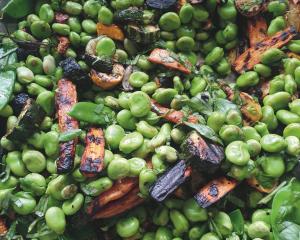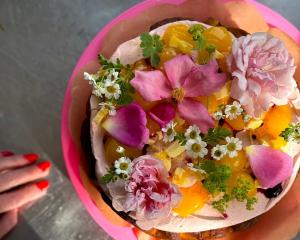He pursued his art from the East Tamaki Dairy Company, in Auckland, to Whitestone Cheese in Oamaru and then Gibbston Valley Cheese, until he and his wife fell in love with a property at Benhar, and moved to South Otago.
From there he began offering weekend cheese-making courses around the South Island.
These have proved so popular that people book months ahead and travel from miles around to attend.
Dave says his absolute passion is camembert, but he calls those sold in the supermarket "Plasticine images" .
He says demand from supermarket chains for a cheese that keeps a long time has led to "stabilised" cheeses that stay the same for weeks without ripening.
The cheeses we made on his course will ripen and ooze across the plate - if we have treated them well since taking them home.
Dave also sells cheese-making equipment via his internet site (www.cheesemaker.co.nz).
Dave Milner's yoghurt cheese with herbs or fruit
A soft cheese style ideal for cooking, dessert or as a snack on crackers.
Requirements:
2 stainless steel pots, 1 large and one smaller to fit inside (double-boiler system).
Stirrer (metal or teflon spoon).
Cheesecloth bag (cut 1m length and tie knot in one end)
Ingredients
5 litres pasteurised milk (use Farmhouse milk from the supermarket in purple 1-litre Tetrapak. Do not use blue top: it is homogenised and not suitable.)
500ml standard cream
½ cup plain (living) non-flavoured yoghurt, or starter culture (mesophile)
½ tsp rennet mixed with 3tsp cold water.
Day 1
Place large stainless pot on stove and fill with cold water.
Add milk and cream to smaller stainless steel pot, place inside large pot and heat to 36degC.
Add starter culture or plain yoghurt and rennet to milk in tub.
Stir gently for 30 seconds and leave quiescent.
Leave at room temperature overnight (16-18 hours).
After 16-18 hours
Cut curds into about 40mm-square cubes.
Add curds gently to cheesecloth bag and hang overnight at room temperature (12-18degC) to allow drainage of moisture (whey).
Day 2
Remove curds from cheesecloth and add herbs or other additives. Mix well.
Store in fridge and eat within 7 to 10 days.
Note: During your cheese-making experience, think hygiene (keeping everything clean) at all times. Sterilise equipment with boiling water.












